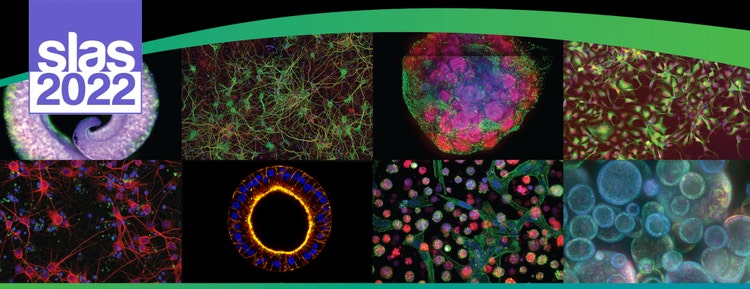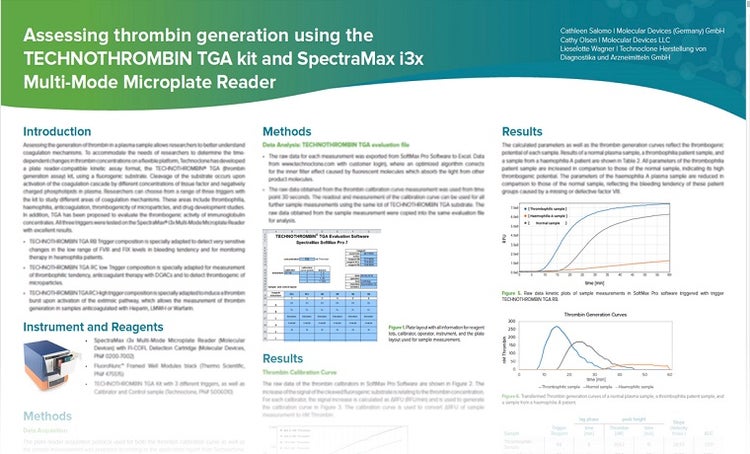
#SLAS2022에서 실험실 실험과정 자동화를 사용한 차세대 오가노이드 엔지니어링
SLAS2022, 실험실 자동화 및 스크리닝 협회 회의는 혁신적인 실험실 기술에 대해 배울 수 있는 또 다른 흥미진진한 한 해가 될 것입니다. Whether you attended in-person or visited us online at our virtual events page, we were excited to share new methods and protocols to automate your complex biology workflows.
Here’s a brief overview of our poster presentations that run the gamut of valuable topics — from new advancements in engineering next-generation organoids to developing an automated lab workflow for 3D cell culture, monitoring, and high-content imaging.
Scientific Poster Presentations
1. 자동화된 Screening Assay를 위한 장 오가노이드. 오가노이드 형태의 High-Content Imaging과 분석
Authors: Oksana Sirenko, PhD, Sr. Scientist; Krishna Macha, PhD, Research Scientist; Angeline Lim, PhD, Applications Scientist
https://share.vidyard.com/watch/Sd2VsnvWqs5m2gHkwnvZdg
3D cell models representing various tissues were successfully used for studying complex biological effects, tissue architecture, and functionality. However, the complexity of 3D models remains a hurdle for the wider adoption in research and drug screening.
여기에서는 오가노이드 배양 자동화를 위한 실험과정을 설명합니다. The automated method utilizes an integrated work-cell, consisting of several instruments providing automated cell culture, monitoring, and high-content imaging. The integrated system includes our ImageXpress® Confocal HT.ai High-Content Imaging System, automated CO2 incubator, automated liquid handler (Biomek i7), as well as a collaborative robot. We developed methods for automating the seeding, media exchange, and monitoring of intestinal organoids development. In addition, the method allows for automation of compound testing and evaluation of phenotypic changes.
Register for our poster presentation where we’ll discuss our methods and demonstrate the tools used to increase throughput and automate organoid assays and compound screening. We’ll also propose analysis approaches that allow you to gain more information about these complex systems, disease phenotypes, and compound effects.
Register to download SLAS posters
2. 생체모사칩 Assay의 자동화: 배양, Imaging, 혈관 형성 분석 자동화
Authors: Angeline Lim, PhD, Applications Scientist; Oksana Sirenko, PhD, Sr. Scientist; Arthur Stok, Matthew Delport, Product Manager, MIMETAS; Francis Enane, Bhagya Wijayawardena
https://share.vidyard.com/watch/x5n3AMEEaf5xEAJCrC8jMW
인간 생물학과 더 유사한 생물학적 모델 시스템이 정말 필요합니다. Three-dimensional (3D) cell models and organ-on-a-chip structures representing various tissues were successfully used for studying complex biological effects, tissue architecture, and functionality. The OrganoPlate® was developed as an organ-on-a-chip platform allowing the formation of 3D microfluidic-based, long-term cultures of live cells. However, the complexity of 3D models remains a hurdle for wider adoption in research and drug screening. Automation of the cell culture, assays, and analysis can provide the tools necessary to facilitate and scale up the use of organ-on-a-chip systems.
Here, we describe a workflow for automating organ-on-a-chip culture, as well as monitoring and automating cell analysis. This automated method utilizes an integrated work-cell consisting of several instruments that allow the automation and monitoring of cell culture. We developed methods for the automation of cell seeding, media exchange, and for monitoring the development and growth of 3D vasculature. In addition, these methods facilitate automated compound testing and evaluation of toxicity effects. We have used the angiogenesis assay as an example of the automation process.
Register for our poster presentation where we review the phenotypic readouts that allowed for quantitative characterization of the extent and complexity of the angiogenic sprouts in 3D. We’ll also discuss how the automated method designed is extensively applicable for compound screening and using organ-on-chip technology in a high-throughput manner.
Register to download SLAS posters
3. Automation-based 3D organoid culture workflow with deep-learning-based label-free image analysis
Authors: Angeline Lim, PhD, Applications Scientist; Misha Bashkurov, PhD, Product Owner; Joe Chen, Automation Solutions Engineer; Oksana Sirenko, PhD, Sr. Scientist
https://share.vidyard.com/watch/iaMAJtdpJD5Dq5VFoqSmg5
The 3D cell culture model system is increasingly popular because it recapitulates the in vivo microenvironment better than 2D cell cultures. 3D organoids are cellular aggregates derived from pluripotent stem cells or adult stem cells and can self-organize into organ-like structures. These organoids have the capacity for stable differentiation and rapid growth and, as such, the organoid model system offers huge potential in disease modeling, drug screening, and precision therapy.
The technologies available for using organoids as a model system are still in their infancy compared to the more established 2D culture or animal models. More development is needed to address the reproducibility of organoids between batches and to standardize and improve the process of organoid culture. In addition, current protocols for the generation and maintenance of organoids are complex, time-consuming, and require extensive manual handling.
Register for our poster presentation as we demonstrate the feasibility of using an automated work cell for the culture and monitoring of 3D pulmonary organoids. These results provide the foundational workflow which can be adapted for other 3D cell models such as intestinal, brain, or patient-derived tissues, and enable scaling-up of organoid production for other downstream applications.
Register to download SLAS posters
4. Simplified, user-friendly, automated workflow for phenotypic profiling based on the Cell Painting assay
Authors: Angeline Lim, PhD, Applications Scientist; Michael Hayes, PhD, Beckman Coulter Life Sciences; Francis Enane, PhD, Sr. Applications Scientist, Beckman Coulter Life Sciences; David Egan, PhD, Co-founder and CEO, Core Life Analytics; Victor Wong, PhD, Application Scientist, Core Life Analytics
https://share.vidyard.com/watch/EedQwmnwXDix1BCpDxYMVT
Multiparametric high-content screening approaches, such as the Cell Painting assay, are increasingly being used in many applications ranging from drug discovery programs to functional genomics screening. The Cell Painting assay uses up to six fluorescent dyes to label and visualize a variety of organelles at the single-cell level. Morphological features extracted from the assay give unique cellular “signatures” that provide an overview of the cell.
Cell Painting assays are typically carried out at scale with multiple assay plates. The workflows can be time and labor-intensive, taking several days to complete a screen. The use of automation that includes liquid handlers could help to streamline these processes, saving valuable user time and increasing assay throughput. In addition, the sheer volume of data generated from these experiments requires powerful software and computational tools to extract meaningful information. The computing requirements needed to run the analysis of these large datasets may be beyond the technical means of smaller research labs.
Here, we developed a complete automated workflow for the Cell Painting assay with the added benefits of reduced hands-on time and user handling errors, with increased assay throughput.
Register to download SLAS posters
5. Assessing thrombin generation with the TECHNOTHROMBIN TGA kit on the SpectraMax i3x Multi-Mode Microplate Reader
Authors: Cathy Olsen, PhD, Application Scientist

Assessing the generation of thrombin in a plasma sample allows one to better understand coagulation mechanisms. To meet the needs of researchers to determine the time-dependent changes in thrombin concentrations on a flexible platform, Technoclone has developed a plate reader-compatible kinetic assay format, the TECHNOTHROMBIN® TGA kit, using a fluorogenic substrate. Cleavage of the substrate occurs upon activation of the coagulation cascade by different concentrations of tissue factor and negatively charged phospholipids in plasma.
Researchers can choose from a range of three triggers with the kit to study different areas of coagulation mechanisms. These areas include thrombophilia, haemophilia, anticoagulation, thrombogenicity of microparticles, and drug development studies. All three triggers were tested on the SpectraMax® i3x Multi-Mode Microplate Reader with excellent results.
After generating the data in SoftMax Pro® Software the data were transferred to Technoclone’s TECHNOTHROMBIN TGA evaluation file to calculate all thrombin generation parameters based on the thrombin generation curve. This poster demonstrates that the combination of the SpectraMax i3x reader and TECHNOTHROMBIN TGA kit offers an ideal platform to perform thrombin generation assays with good precision for research use.
Register to download SLAS posters
Explore solutions for automating your 3D biology workflows
Whether you’re just starting to explore the benefits of 3D tissue models and imaging or leveraging advanced 3D workflows, we offer solutions for the complexities that come with organoid acquisition and analysis.
Visit our Organoid Innovation Center to discover our newest collaborative space bringing customers, researchers, and in-house scientists together to test automated workflows for organoid culturing and screening. Automate your 3D culture workflows and quickly adopt innovative, 3D biological methods and technologies to reduce lab costs and push the boundaries of your research.